St Andrews Beach, Australia
by Mark Ferguson
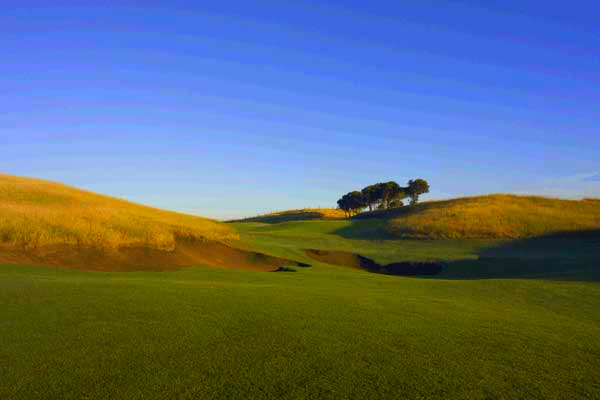
The ninth hole – golf land this good is rare in Melbourne and most other places in the world.
Why do we choose to become members of a particular golf club?
For many of us, I would guess, the choice is out of our hands; we are sponsored into clubs by friends and associates, and thus, the merits of a certain course may play no role in our decision, unless we are fortunate enough to have a choice of several. For others, it is possible to buy your way into a club by purchasing a transferable share. Such has been a common method of funding new courses in the USA for many years, and, increasingly in recent times, Australia.
Does this method, though, alter in any appreciable way arguably the most important factor in joining a club, that of surrounding yourself with people whom you enjoy the company of for several hours one or two fine afternoons or mornings a week?
Happily, at the Golf Club St Andrews Beach, around an hour’s drive south of Melbourne, the establishment of a world-class golf course has gone hand-in-hand with the formation of a wonderful club. This is due in no small part to the developers of the project wanting such a club, but also to the nature of the course itself.
The club is located on the Mornington Peninsula, an area of diverse activities; a holiday playground for the more well-to-do, home to some of the best wineries in the country, and, increasingly in the past decade or so, golf. The Sandbelt of the Melbourne suburbs, of course, is world famous, despite the limitations of the land itself. Although sand-based, with the exception of Royal Melbourne and to a lesser extent its near neighbour, Victoria, none of the courses have the benefit of undulation common to many of the other great courses of the world. Rather, it was classic design principles accompanied by brilliant construction that has enabled these clubs to achieve their lofty status.
The area most of the new golf developments on the Mornington Peninsula are built upon is known as ‘Cups Country’, and consists of dramatic tumbling sand-based dunes, thereby assuring a head start over every other course in the state. Yet, with the exception of Greg Norman’s Moonah course at The National Golf Club, none of the recent developments could be said to live up to the promise of the land.
The Gunnamatta course, designed by Tom Doak in conjunction with Mike Clayton, is the first of two courses on a sprawling and beautifully undulating 175 hectare site that was formerly pastoral land. It has been open for limited play since the beginning of the year, with the official opening in late November. Despite being in a somewhat raw state, with much revegetation work in its infancy and much more to be done, the course is arguably amongst the top three or four in the country, and in future years should live up to the developer’s and members’ hope to be ranked amongst the finest in the world.
The opposite of many new developments, the Gunnamatta course is a trip back in time, as it measures only 6060 metres, with a par of 70. There are just two par-fives, the 1st and 17th, and four exceptional short par-fours, the 2nd, 8th, 9th and 14th, which constrain the overall yardage. Situated some five hundred metres from the ocean, in an area known for the occasional ferocity of the wind, the layout features wide fairways and little rough to torment the average player, although plentiful growth exists for those a little too out of control.
There are a number of adjectives that could be used to describe the course. Spectacular, thrilling, unique, imaginative, deceptive, old-fashioned and rich with variety would be the first to come to mind. Perhaps the most important, however, is inspiring. The undulating nature of the property allows a number of high tees, which provide plenty of thrilling drives. There are a number of unique green sites, such as the amphitheatre 3rd, the 6th, a par three cut above a bunker-gouged ridge, the wild 9th, the small knob green of the 10th, which resembles Dornoch’s 14th in the nature of the difficulty of the approach, the tiny 13th in another small amphitheatre of its own, and finally the home hole, situated in a Moonah-tree filled bowl.

The thirteenth is an inspiring 452 metre par four over a dramatically tumbling fairway.
The Gunnamatta course harks back to the so-called Golden Age of Design in that it is eminently playable by the average golfer, but demands relentless precision for the better player hoping to post a score. Although there is a relative paucity of bunkers when compared to other classic seaside courses, they are invariably in the spot guarding the ideal line into the small greens. Entirely rugged and natural, the bunkers look to have been carved by animals and the wind more than by the hands of man and machine.

The seventeenth hole playing 468 metres, is prime example of the beautiful bunkers and green complexes found on the Gunnamatta course.
There are supposed architectural anomalies, in having just two par-fives, several blind drives, five or six blind second shots, depending on the strength and direction of one’s tee shot, tees offset from the fairway, plateau greens, front-to-back sloping greens, punchbowl greens, as well as the thoroughly eccentric 9th green, which features not so much a buried elephant beneath its surface as an epileptic break dancing hippopotamus, all providing a rich and enjoyable variety of holes. The routing changes direction often enough to take full advantage of the ever present breeze, further enhancing the day-to-day differences in the way the holes play. The greens, on the whole, are subtly contoured and sloped, although several have dramatic rolls, and, again contrary to much modern design, the short game is strongly emphasised by the wide aprons surrounding many of the greens and the general lack of rough.
First: The most spectacular hole on the property starts proceedings. At 497 metres, it is generally played into the prevailing wind. From a tee fifty feet above the fairway, one aims for a bunker right that appears far out of range, but isn’t that far away, leaving you momentarily with that horrid feeling that the round will be off to an imperfect start. You then face an interesting challenge for your second; shoot blind over the bunkered crest that protects the small green, or lay-up between the ridge and another bunker right for your third. Protected by a solitary bunker, the green is a model of subtlety, with a steep fall off behind ensuring your first pitch of the day had better be spot on.
Second: The Sandbelt is renowned for having several brilliant short par-fours, and the Gunnamatta course happily continues this tradition. Only 279 metres, the fairway dips from the tee into a shallow valley, before rising gently to a long, undulating green protected by a blown-out sand dune to the left and front, as well as bunkers behind. One can take on a bunker and another natural sand hazard right from the tee and hope the drive has the perfect weight to trundle down a right-to-left slope onto the green, lay up with an iron, or head toward the blown-out dune left, which leaves a semi-blind second, but gives you more green to work with.
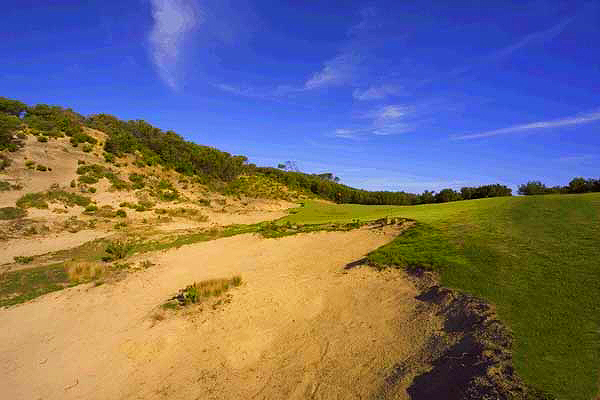
The glorious second Hole – 279 metres of utter temptation.
Third: At 405 metres, with a blind drive around the base of a sand hill, this is the number one handicap hole. The drive is fairly innocuous, but it is when you arrive at your tee ball to see the spectacular and unique shot that awaits that you realise not every great par four has to consist equally of a great first and second shot. Your second is fired to a long green set in its own amphitheatre, a bunker-scarred dune to the left vexing those who have driven left from the tee. The Ëœramp’ that leads from fairway to green also causes confusion as to the exact location of the flag. Yardage charts, in part because of the wind, but more because of the nature of such holes, are relatively useless at Gunnamatta. Coupled with a green that has its high point in the centre and falls away front and back, there are any number of vexatious pin positions.
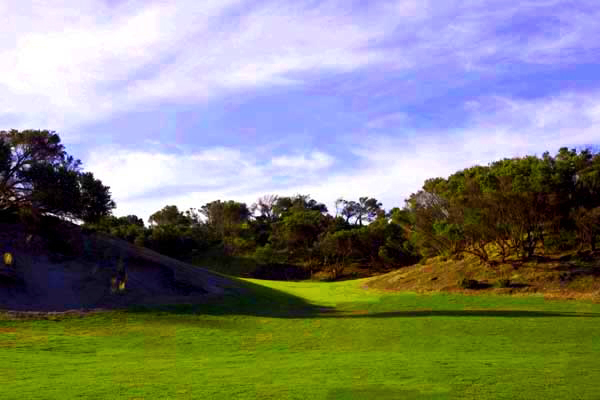
The incredible and unique third hole.
Fourth: At 197 metres and generally into the prevailing breeze, the third and fourth contrast with the first two reasonably forgiving holes in being quite difficult. Played across a valley to a green situated just beyond a ridge that steers marginal approach shots into bunkers either side, the green is subtle in the extreme. Some might say too subtle ¦
Fifth: A super sleeper-type hole. From another high tee, offset from the fairway and 395 metres to the green ahead, one fires a drive as close as possible to a diagonal bunker left. Or do he? The front-to-back sloping punchbowl green is protected by a bunkered ridge on that line, meaning approach shots must be perfectly weighted in order not to fly the green. Go right from the tee, and you have a better angle into the green and no bunker to contend with, but your second will be blind because of a crest in the fairway on this line. The green is another subtle one, sloping from front-to-back and left-to-right. A hole where it is easy to take five without really making a mistake.
Sixth: 167 metres, slightly uphill, this is another tough par three. The green is located above a bunker-gouged sand hill, and has another very deceptive feature; a crown front left deceives the golfer standing on the tee as to exactly where the flagstick is located. Miss left, and the ball could trundle back down the hill, leaving a fifty metre pitch back to the green, most likely over the bunker. Better to be long than short, but I wouldn’t know. In thirty-odd rounds, I’ve yet to hit the damn thing. Mixing up the design balance, the green is both bold and subtle.
Seventh: 377 metres, but plays at least two clubs downhill. Somewhat innocuous from the tee, you only need to fly the central fairway bunker, then fire an accurate second to a slender two-tiered green. Downwind, approach shots must be hit into the bunkered bank fronting the green to stop for frontal pin positions, whilst the tier acts as a backstop for rear positions.
Eighth: 338 Metres. From another high tee, the fairway sweeps away in a series of rolling ridges. Best line into the small bunkerless green is from the right, near the omnipresent bunkers. Ideally, you want to be either on top of a ridge for your second, or on the flat in a valley. An uphill slope, with the Peninsula winds either for or against, would guarantee a nightmarish pitch. The green is the smallest on the course, and subtly contoured, with a wide apron to the right and plenty of room behind and to the left. A crown front left deflects approach shots coming from that direction.
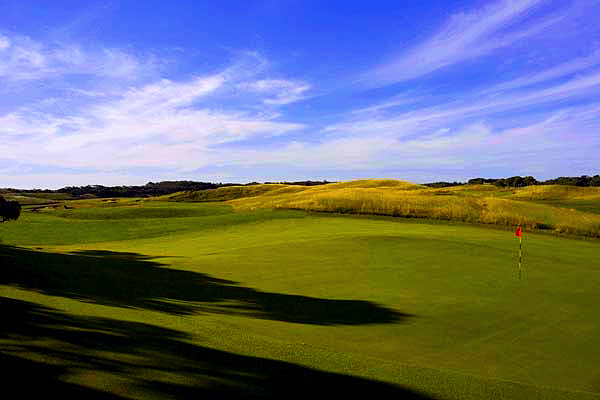
Another bunkerless – and small “ green. Especially hard to hit from the lies liable on one of the fairway ridges.
Ninth: 335 metres. From a tee benched halfway up a small dune, you drive to a wide fairway with the far bunkers seemingly out of reach, yet, downwind, they are definitely in play. The second is played to a unique green, a large domed ridge running from front right to back left playing havoc with approach shots. One can become so preoccupied with the green, you forget about the bunker front left.
Tenth: 384 Metres. A left-to-right dogleg downhill to a wonderful tumbling fairway. From the tee, the green appears far, far away. Ideal line is at or over the fairway bunkers right. Your second is then slightly uphill to a small knob green bunkered right and behind, with a steep slope running off the left of the green. A legitimate tactic with anything more than a 5-iron is to lay up just short and chip on. Although when were golfers that sensible?
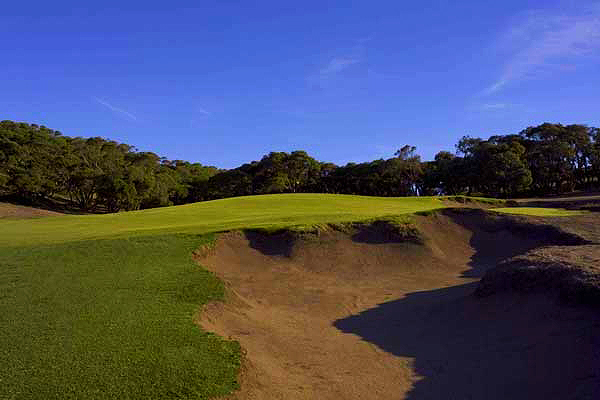
The small, dangerous and brilliant knob green of the brilliant tenth hole.
Eleventh: 147 Metres. Two tees, one where you play straight up the green, the other 50 metres right means you play across. Small, narrow and undulating and protected by bunkers right and left, shots long left can tumble down the ridge the green is draped across and leave a multitude of recovery options: bump and run, pitch, lob or simply picking up and storming to the 12th.
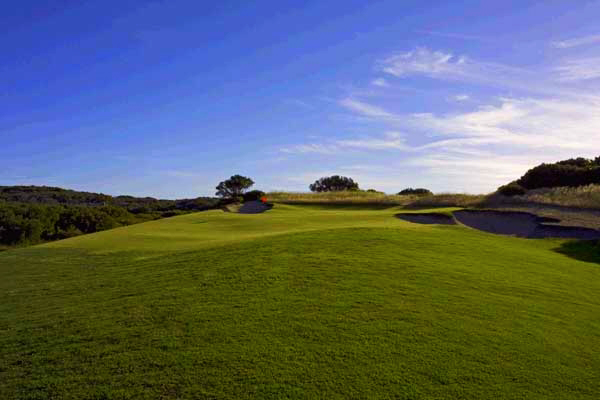
The eleventh – another natural par three.
Twelfth: 389 Metres. A hole that highlights the difference tee markers can have. From 40 metres further forward and slightly left, this left-to-right dogleg appears reasonably benign. From the back, a small ridge partially obscures the view as well as changing the angle of the drive ever so slightly, and for the better. Regardless, this is a reverse dogleg, where the outside provides a reasonably uninterrupted (there is another large swell fronting the green) view of one of the larger greens. Going the direct way, though shorter, means your second will have to be fired over and between the two guardian bunkers, and have to contend with another slippery dip at the side and rear, too. The green has a subtle ridge running from the front bunker toward the middle of the green, and contains many double-breaking putts. According to one of Tom Doak’s buddies during last year’s Renaissance Cup, failure to read these greens means you ‘just got Doaked’, although I prefer my rather less charitable version.
Thirteenth: 452 Metres. But a par four. And a blind drive over a hollow to boot. Never mind. Once over a ridge, a majestic tumbling fairway rolls away from you to the tiny bunkerless green in its own amphitheatre some 200-plus metres away. A pair of massive bunkers have been gouged from a dune some 50 metres short of the green, frustrating those who have driven right. There is plenty or room around the green to chip wayward or short second shots, and the green is small enough to ensure you won’t have a very long putt, but that’s only if you don’t have to putt over the small ridge that bisects the green, or the shaved bank at the front.
Fourteenth: After two tough holes, a respite of a sort. A short par four of 270 metres, the green is a narrow, undulating ledge protected by a bunker-scarred hill. The fairway bunkers aren’t really in play, which is perhaps part of the tactical ploy, encouraging one to give the drive something extra in a vain attempt to have but a chip or pitch left. Such tactics usually mean firing wide of the slim green, and then pitching directly across and toward that bunker-scarred hill. Or worse, over it.
Fifteenth: 361 metres. Again, the tees used make much difference. From the back, the fairway drops alarmingly as you attempt to drive to a tumbling plateau, then fire a second from a no doubt uneven lie to another bunkerless green, and another skinny one to boot. From the front tee, the hole is 60-odd metres shorter and more straight on, relieving the pressure on the drive, and negating some of the excitement. I like this hole because of the sheer drama of the land, but for most members it is the most innocuous on the course. Peasants!, I say.
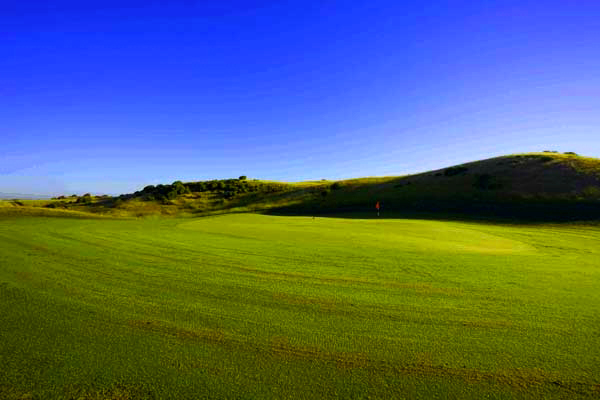
The fifteenth – an example of the slightly different terrain on this part of the course.
Sixteenth: 197 metres. A Redan-type par three downhill to a tough-to-hit green where the ball, ideally, should be landed well short with a running draw, perilously close to a guardian bunker, if it is to have any chance of staying on the putting surface, which slopes much more sharply toward the bank left than it appears. There is also a back tee of 240 metres, which is Tom’s surprise ‘present’ to the design, and which several masochists have taken on.
Seventeenth: 468 Metres. A rare right-to-left dogleg, along a schizophrenic fairway; the left side is relatively flat, the right a severe – but not so severe your ball won’t hold – sidehill slope. The left side, naturally, is protected by three bunkers, and then you have a semi-blind second to an undulating green protected by bunkers left front and rear, and another sharp drop off to the left side.
Eighteenth: 404 metres. A series of bunkers roll out from a central Moonah-tree studded bunker complex and protect the ideal line into a long, narrow green protected right and left front and right rear by bunkers. The green also has a large ridge running across the left hand side.
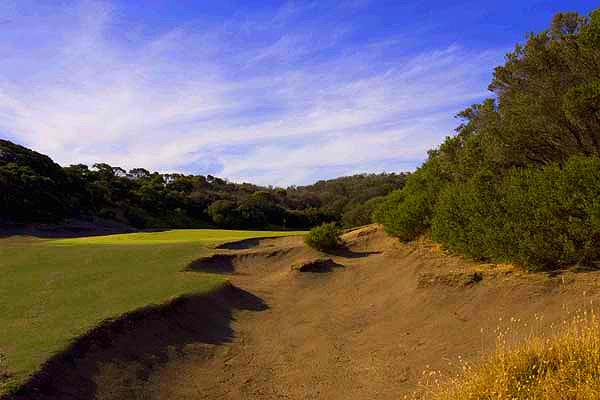
The stunning eighteenth green complex from the right.
The Gunnamatta course is one that emphasises just how wrong nearly all designers have been since the end of the so-called Golden Age of design. Eminently playable by the beginner or casual duffer, the precision required to post a score makes it forever appealing, and no doubt frustrating, to the low handicapper as well. In an area of often frightening weather, the flexibility of the layout means it can be enjoyed under all conditions, as I can personally attest after a couple of Sunday afternoons this year. It is a course whose main aim is to be fun and inspiring, and show all who are fortunate enough to play it just what a spine tingling combination great architecture and land can be.
Best of all, the club has so far attracted a keen coterie of golf aficionados, many of whom signed up when the course was little more than a paddock, and who have seen the course magically arise from the ground as if it was always meant to be there. The two together promise not just one of the great courses of the world, but one of the great clubs too.
The End







